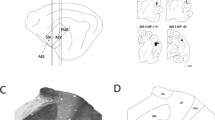Abstract
The thalamic relays for the conduction of impulses arising during photic stimulation of the eyes and electrical stimulation of the tectum in the general cortex, hyperstriatum (the dorsal ventricular ridge), and the striatum proper were studied in the turtleEmys orbicularis. Acute experiments on immobilized animals showed that anodal polarization temporarily and destruction of n. rotundus irreversibly suppress the main negative wave of the responses to tectal stimulation and to flashes in the hyperstriatum, whereas the corresponding responses in the general cortex still persist. Polarization and destruction of the lateral thalamic region, including the lateral geniculate body, have the opposite effect: responses in the hyperstriatum to photic and tectal stimulation are virtually unchanged whereas those in the general cortex disappear, except their late components. Preceding single stimulation of the tectum or n. rotundus depresses responses in the hyperstriatum evoked by flashes. However, during stimulation of the lateral thalamic region, combined potentials and single unit responses appear in the hyperstriatum and interact with responses evoked by tectal stimulation. It is concluded that the main pathways in turtles which supply visual information to the general cortex and hyperstriatum differ: the former relay in the lateral thalamic region, the latter in n. rotundus, although some overlapping of their projections in the hyperstriatum and striatum is possible.
Similar content being viewed by others
Literature cited
M. M. Akulina, "Electrophysiological investigation of thalamo-mesencephalic relations in turtles," Zh. Évol. Biokhim. Fiziol.,7, 543 (1971).
M. G. Belekhova and M. M. Akulina, "The tecto-thalamo-telencephalic system in turtles (electrophysiological investigation)," Neirofiziologiya,2, 296 (1970).
M. G. Belekhova and M. M. Akulina, "Comparative electrophysiological characteristics of afferent representation in the cortical and striatal divisions of the turtle forebrain," Neirofiziologiya,7, 184 (1975).
V. I. Gusel'nikov, É. D. Morenkov, and A. S. Pivovarov, "Particular features of unitary responses in various parts of the turtle forebrain to visual stimuli," Fiziol. Zh. SSSR,57, 1455 (1971).
A. I. Karamyan, Functional Evolution of the Vertebrate Brain [in Russian], Nauka, Leningrad (1970), 304 pp.
A. I. Karamyan, Evolution of the Vertebrate Brain [in Russian], Nauka, Leningrad (1976). 225 pp.
A. A. Kosareva, "Afferent and efferent connections of the nucleus rotundus of the turtleEmys orbicularis," Zh. Evol. Biokhim. Fiziol.,10, 395 (1974).
L. M. Nomokonova, "Connections of the lateral optic thalamus and adjacent nuclear formations with the telencephalon in the frogRana ridibunda," in: Comparative Neurophysiology and Neurochemistry [in Russian], Nauka, Leningrad (1976), pp. 70–76.
M. G. Belekhova and A. A. Kosareva, "Organization of the turtle thalamus: visual, somatic, and tectal zones," Brain Behav. Evol.,4, 337 (1971).
E. C. Crosby, B. R. Jonge, and R. C. De Schneider, "Evidence for some of the trends in the phylogenetic development of the vertebrate telencephalon," in: Evolution of the Forebrain, Georg Thieme Verlag, Stuttgart (1966), pp. 117–135.
S. O. E. Ebbesson and D. M. Schroeder, "Connections of the nurse shark's telencephalon," Science,173, 254 (1971).
W. C. Hall and F. F. Ebner, "Parallels in the visual afferent projections to the thalamus in the hedgehog (Paraechinus hypomelas) and the turtle (Pseudemys scripta)," Brain Behav. Evol.,3, 135 (1970).
W. C. Hall and F. F. Ebner, "Thalamo-telencephalic projections in the turtle (Pseudemys scripta)," J. Comp. Neurol.,140, 101 (1970).
W. Hewitt, "The basal ganglia ofTestudo graeca," J. Comp. Neurol.,131, 605 (1967).
P. Hoogland, I. van Woerden-Verkley, and A. Lohman, " Efferent and afferent connections of the striatal complex in the lizard,Tupinambis nigropunctatus," Exp. Brain Res.,23, Suppl.,93, (1975).
J. B. Johnston, "The cell masses in the forebrain of turtleCistudo carolina," J. Comp. Neurol.,25, 393 (1915).
J. W. Papez, "Thalamus of turtle and thalamic evolution," J. Comp. Neurol.,61, 433 (1935).
A. Parent, "Striatal afferent connections in the turtle (Chrysemys picta) as revealed by retrograde axonal transport of horseradish peroxidase," Brain Res.,108, 25 (1976).
M. Pritz, "Ascending connections of a thalamic auditory area in a crocodile,Caiman crocodilus," J. Comp. Neurol.,153, 199 (1974).
M. Pritz, "Anatomical identification of a telencephalic visual area in crocodiles: ascending connections of nucleus rotundus inCaiman crocodilus," J. Comp. Neurol.,164, 323 (1975).
Additional information
I. M. Sechenov Institute of Evolutionary Physiology and Biochemistry, Leningrad. Translated from Neirofiziologiya, Vol. 9, No. 5, pp. 486–494, September–October, 1977.
Rights and permissions
About this article
Cite this article
Belekhova, M.G. Transthalamic conduction of visual impulses to the cortex and subcortical forebrain structures in turtles. Neurophysiology 9, 367–373 (1977). https://doi.org/10.1007/BF01063639
Received:
Issue Date:
DOI: https://doi.org/10.1007/BF01063639




